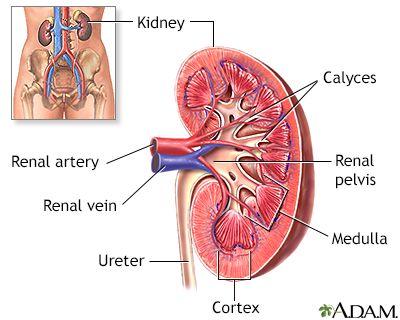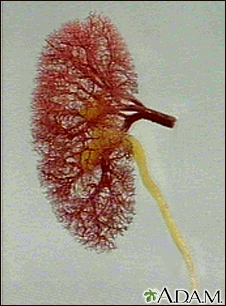Prerenal azotemia
Prerenal azotemia is an abnormally high level of nitrogen waste products in the blood.
Causes
Prerenal azotemia is common, especially in older adults and in people who are in the hospital.
The kidneys filter the blood to make urine that removes waste products. When the amount, or pressure, of blood flow through the kidney drops, filtering of the blood also drops. Or it may not occur at all. Waste products stay in the blood. Less urine is made, even though the kidney itself is working.
When nitrogen waste products, such as creatinine and urea, build up in the body, the condition is called azotemia. These waste products act as poisons when they build up. They damage tissues and reduce the ability of the organs to function.
Prerenal azotemia is the most common form of reduced kidney function in hospitalized people. Any condition that reduces blood flow to the kidney may cause it, including:
Kidney function
Acute kidney failure is the rapid (less than 2 days) loss of your kidneys' ability to remove waste and help balance fluids and electrolytes in your b...

- Burns
- Conditions that allow fluid to escape from the bloodstream
- Long-term vomiting, diarrhea, or bleeding
- Heat exposure
- Decreased fluid intake (dehydration)
Dehydration
Dehydration occurs when your body does not have as much water and fluids as it needs. Dehydration can be mild, moderate, or severe, based on how much...
 ImageRead Article Now Book Mark Article
ImageRead Article Now Book Mark Article - Loss of blood volume
- Certain medicines, such as ACE inhibitors (medicines that treat heart failure or high blood pressure) and non-steroidal anti-inflammatory drugs (NSAIDs)
Conditions in which the heart cannot pump enough blood or pumps blood at a low volume also increase the risk for prerenal azotemia. These conditions include:
- Heart failure
Heart failure
Heart failure is a condition in which the heart is no longer able to pump oxygen-rich blood to the rest of the body efficiently. This causes symptom...
 ImageRead Article Now Book Mark Article
ImageRead Article Now Book Mark Article - Shock (septic shock)
Septic shock
Septic shock is a serious condition that occurs when a body-wide infection leads to dangerously low blood pressure.
Read Article Now Book Mark Article
It can also be caused by conditions that interrupt blood flow to the kidney, such as:
- Certain types of surgery
- Injury to the kidney
Symptoms
Prerenal azotemia may have no symptoms. Or, symptoms of the causes of prerenal azotemia may be present.
Symptoms of dehydration may be present and include any of the following:
- Confusion
Confusion
Confusion is the inability to think as clearly or quickly as you normally do. You may feel disoriented and have difficulty paying attention, remembe...
 ImageRead Article Now Book Mark Article
ImageRead Article Now Book Mark Article - Decreased or no urine production
Decreased or no urine production
Decreased urine output means that you produce less urine than normal. Most adults make at least 500 milliliters of urine in 24 hours (a little over ...
 ImageRead Article Now Book Mark Article
ImageRead Article Now Book Mark Article - Dry mouth due to thirst
Dry mouth
Dry mouth occurs when you don't make enough saliva. This causes your mouth to feel dry and uncomfortable. Dry mouth that is ongoing may be a sign o...
 ImageRead Article Now Book Mark Article
ImageRead Article Now Book Mark Article - Fast pulse
Fast pulse
A bounding pulse is a strong throbbing felt over one of the arteries in the body. It is due to a forceful heartbeat.
 ImageRead Article Now Book Mark Article
ImageRead Article Now Book Mark Article - Fatigue
- Pale skin color
Pale skin color
Paleness is an abnormal loss of color from normal skin or mucous membranes.
 ImageRead Article Now Book Mark Article
ImageRead Article Now Book Mark Article - Swelling
Exams and Tests
An exam may show:
- Collapsed neck veins
- Dry mucous membranes
- Little or no urine in the bladder
- Low blood pressure
Low blood pressure
Low blood pressure occurs when blood pressure is much lower than normal. This means the heart, brain, and other parts of the body may not get enough...
 ImageRead Article Now Book Mark Article
ImageRead Article Now Book Mark Article - Low heart function or hypovolemia
Hypovolemia
Hypovolemic shock is an emergency condition in which severe blood or other fluid loss makes the heart unable to pump enough blood to the body. This ...
Read Article Now Book Mark Article - Poor skin elasticity (turgor)
Turgor
Skin turgor is the skin's elasticity. It is the ability of skin to change shape and then return to normal.
 ImageRead Article Now Book Mark Article
ImageRead Article Now Book Mark Article - Rapid heart rate
- Reduced pulse pressure
- Signs of acute kidney failure
Acute kidney failure
Acute kidney failure is the rapid (less than 2 days) loss of your kidneys' ability to remove waste and help balance fluids and electrolytes in your b...
 ImageRead Article Now Book Mark Article
ImageRead Article Now Book Mark Article
The following tests may be done:
- Blood creatinine
Blood creatinine
The creatinine blood test measures the level of creatinine in the blood. This test is done to see how well your kidneys are working. Creatinine in t...
 ImageRead Article Now Book Mark Article
ImageRead Article Now Book Mark Article - Blood urea nitrogen (BUN)
Blood urea nitrogen
BUN stands for blood urea nitrogen. Urea nitrogen is what forms when protein breaks down. A test can be done to measure the amount of urea nitrogen ...
 ImageRead Article Now Book Mark Article
ImageRead Article Now Book Mark Article - Urine osmolality and specific gravity
Urine osmolality
The osmolality urine test measures the concentration of chemicals in urine. Osmolality in the blood can be measured using a blood test.
 ImageRead Article Now Book Mark Article
ImageRead Article Now Book Mark Article - Urine tests to check sodium and creatinine levels and to monitor kidney function
Sodium
The sodium urine test measures the amount of sodium the urine. Sodium can also be measured in a blood sample.
 ImageRead Article Now Book Mark Article
ImageRead Article Now Book Mark ArticleCreatinine
The creatinine urine test measures the amount of creatinine in urine. This test is done to see how well your kidneys are working. Creatinine in the ...
 ImageRead Article Now Book Mark Article
ImageRead Article Now Book Mark Article
Treatment
The main goal of treatment is to quickly correct the cause before the kidney becomes damaged. People often need to stay in the hospital.
Intravenous (IV) fluids, including blood or blood products, may be used to increase blood volume. After blood volume has been restored, medicines may be used to:
Intravenous
Intravenous means "within a vein. " Most often it refers to giving medicines or fluids through a needle or tube inserted into a vein. This allows th...
Read Article Now Book Mark Article- Increase blood pressure
- Improve the pumping of the heart
If the person has symptoms of acute kidney failure, treatment will likely include:
- Dialysis
Dialysis
Dialysis treats end-stage kidney failure. It removes harmful substances from the blood when the kidneys cannot. This article focuses on peritoneal d...
Read Article Now Book Mark Article - Diet changes
- Medicines
Outlook (Prognosis)
Prerenal azotemia can be reversed if the cause can be found and corrected within 24 hours. If the cause is not fixed quickly, damage may occur to the kidney (acute tubular necrosis).
Acute tubular necrosis
Acute tubular necrosis (ATN) is a kidney disorder involving damage to the tubule cells of the kidneys, which can lead to acute kidney failure. The t...

Possible Complications
Complications may include:
- Acute kidney failure
- Acute tubular necrosis (tissue death)
When to Contact a Medical Professional
Go to the emergency room or call 911 or the local emergency number if you have symptoms of prerenal azotemia.
Prevention
Quickly treating any condition that reduces the volume or force of blood flow through the kidneys may help prevent prerenal azotemia.
Reviewed By
Walead Latif, MD, Nephrologist and Clinical Associate Professor, Rutgers Medical School, Newark, NJ. Review provided by VeriMed Healthcare Network. Also reviewed by David C. Dugdale, MD, Medical Director, Brenda Conaway, Editorial Director, and the A.D.A.M. Editorial team.
Okusa MD, Portilla D. Pathophysiology of acute kidney injury. In: Yu ASL, Chertow GM, Luyckx VA, Marsden PA, Skorecki K, Taal MW, eds. Brenner and Rector's The Kidney. 11th ed. Philadelphia, PA: Elsevier; 2020:chap 28.
Paine CH, Jefferson JA, Velez JCQ. Pathophysiology and etiology of acute kidney injury. In: Johnson RJ, Floege J, Tonelli M, eds. Comprehensive Clinical Nephrology. 7th ed. Philadelphia, PA: Elsevier; 2024:chap 70.
Wolfson AB. Renal failure. In: Walls RM, ed. Rosen's Emergency Medicine: Concepts and Clinical Practice. 10th ed. Philadelphia, PA: Elsevier; 2023:chap 83


 All rights reserved.
All rights reserved.